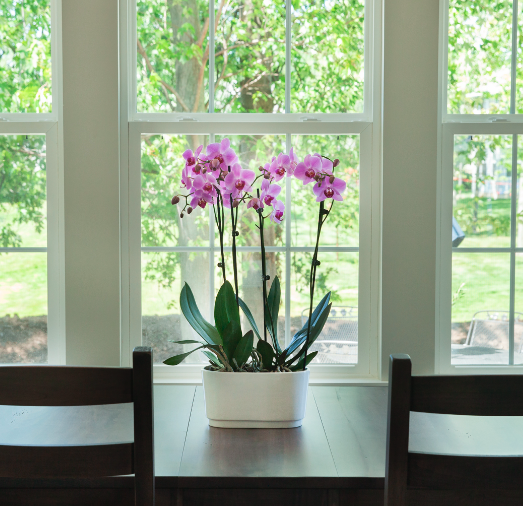
Spring is a pivotal time to add flowers and color to your home. We’ve made it through winter, there’s more sunshine and it’s exciting to see some brightness around your space.
However, there are two important things to remember: care and plant placement. We will dive into both topics in this blog post, so follow along for some helpful tips to keep your orchids beautiful and blooming all through spring.
Finding the best places to keep your orchid isn’t as hard as you think. Although they're tropical plants, orchids grow in many different environments. They’re sophisticated and beautiful on the outside, but on the inside, they are strong adaptable plants. But although they’re tough, they’re not invincible.
Where you set your plant can mean the difference between it thriving and withering. Lighting changes from season to season, so the best places to keep your orchids when there's ample sunlight may be different compared to when there's less light outside.
When it comes to orchids, the word ‘sunlight’ can be a bit intimidating. You want to give your plant what it needs, but you don’t want to give it too much.
When it comes to the sun, we always suggest bright, indirect light. This is especially important in the spring months! Most times, you are transitioning from a cloudier, grey winter, which means too much sun could shock your plant.
Keep your plant in a place that gets some indirect lighting, so you aren’t scorching your plant. Never place your orchid in a direct stream of sunlight.
It’s important to choose the right space in your home for your plant with the changing season. Here’s a list of some great options for your plant.
Orchids thrive in the sunshine, and most times the living room tends to get the most sunlight in your home. Indirect sunlight is best. So, one of the best places to keep your orchid is near a north- or east-facing window. If your living room has west-facing windows, it’s best to place it farther away from the window on a table or shelf.
If you prefer to place your plant closer to the window, make sure the window is draped with a sheer curtain to block out the direct rays of the sun.
Phalaenopsis orchids originated in the tropics, which means they love humidity. What room of your home tends to be the most humid? The bathroom. The steam and heat from your bathroom shower will keep your plant hydrated and warm.
If your bathroom doesn’t have any windows, you should take your plant out of the room for part of the day. Place it in another area of the home with indirect sunlight. Rotating your plant between the bathroom and another room of your house also discourages mold growth from too much moisture.
An orchid is a simple, yet stunning way to beautify your dining room. And since dining rooms tend to be connected to kitchens, your plant can benefit from your kitchen’s warmth. If your kitchen windows face south or west, the afternoon sun will provide warmth. Your orchid will benefit from being exposed to sudden warm blasts from opening and closing the oven door.
When deciding where to place your orchid in the dining room, be sure to keep it far from any fruit bowls you may also have in the room. The ethylene gas emitted by ripening fruit can cause premature dropping of buds.
Do you work from home? Adding a plant (or two) is a wonderful way to liven up your workspace. It may even increase your creativity and productivity.
Home offices are also one of the best places to keep your orchid because they tend to be well-lit with natural sunlight. This will help your orchids get all the light they need (just be sure to keep an eye on your plant’s leaves to ensure they’re not getting sunburned).
What’s better than waking up to a beautiful orchid flowering on your nightstand or gazing at an orchid resting near a window? In addition to the kitchen, your bedroom is another room that stays toasty, and like the living room, tends to get a lot of light. If you place your flower near a window, make sure it is insulated against drafts and faces north or east.
Now that you know where to keep your orchid in your home, let’s look at how you can best care for it. Orchids are relatively easy to care for, but you may need to adapt things a bit for spring and changing seasons.
Now that you have a few ideas of where to keep your plant, let’s talk about a few places we don’t suggest keeping it.
Windows are beautiful and bring in light, but can be damaging to your plant! Many times, the first sign of warmer temperatures encourages us to crack a window for some fresh air. However, if that air is too dry, it can be a bit damaging for your plant, as it needs more moist air.
Cool breezes feel great on those super hot days, but if they aren’t coming from your window, they could be coming from your A/C unit. Those cool, dry drafts will not be friendly to your plant. Keep it somewhere that the draft doesn’t reach.
Similar to breezes and A/C, fans are flower-friendly. While it cools your space and moves air around, the constant movement can be damaging to your plant. If you need to turn on your fan, we suggest moving your plant to another room.
This spring and summer, enjoy the warm weather but consider these precautions to help shield your plant from harm.

Copyright Just Add Ice® Orchids 2023